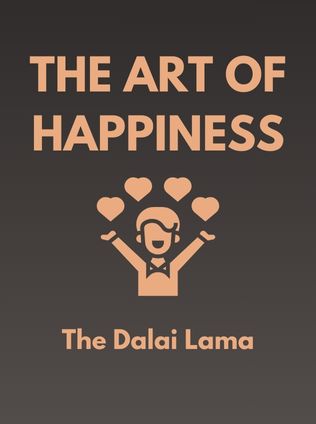
The Art of Happiness
By The Dalai Lama
Published 10/1998
About the Author
The Art of Happiness is a collaborative effort between His Holiness the Dalai Lama, the spiritual leader of Tibetan Buddhism, and Dr. Howard C. Cutler, a practicing psychiatrist. The Dalai Lama is revered globally not only as a religious figure but also as a symbol of compassion, peace, and wisdom. His teachings, grounded in Buddhist philosophy, transcend religious boundaries and offer universal principles for achieving a fulfilling life. Dr. Cutler, with his background in Western psychology, adds a scientific perspective to the Dalai Lama's spiritual insights, creating a dialogue that bridges Eastern and Western approaches to happiness and mental well-being.
The Dalai Lama has long been an advocate for finding inner peace and happiness through compassion, mindfulness, and ethical living. His deep understanding of human nature and the causes of suffering provides the foundation for the teachings presented in The Art of Happiness. Dr. Cutler complements these teachings with practical advice and real-world applications, making the concepts accessible to a broad audience. Together, they explore how individuals can cultivate happiness in their lives, despite the inevitable challenges and suffering that come with being human.
Main Idea
The Art of Happiness asserts that the purpose of life is to seek happiness, and achieving happiness is not merely an emotional state but a mental, emotional, and intellectual process. The Dalai Lama and Dr. Cutler provide practical guidance on how to cultivate happiness by transforming one’s mindset, fostering meaningful relationships, accepting and working through suffering, and integrating spirituality into everyday life. The book emphasizes that happiness is attainable through conscious effort and training, rather than relying on external circumstances or fleeting pleasures.
Table of Contents
- Your Purpose Is to Seek Happiness
- Achieving Happiness Requires Training
- Cultivating a Happiness Mindset
- Building Strong Interpersonal Relationships
- Working to Eliminate Suffering
- Weaving Spirituality Into Daily Life
- Conclusion: The Practice of Happiness
Your Purpose Is to Seek Happiness
The Dalai Lama begins by stating that the primary purpose of human life is to seek happiness. However, he redefines happiness as more than just a fleeting emotional state; it is a deep sense of contentment that encompasses mental, emotional, and intellectual well-being. This holistic view of happiness involves cultivating a resilient state of mind that finds peace and satisfaction in all aspects of life, regardless of external circumstances.
“Happiness is not something ready made. It comes from your own actions.” — Dalai Lama
The Dalai Lama argues that all humans have an innate desire to be happy, but this happiness must be consciously cultivated through intentional actions and mindset shifts. He challenges the common misconception that happiness is dependent on external factors like wealth, success, or relationships. Instead, he emphasizes that true happiness comes from within, rooted in a peaceful and contented mind.
- Many people pursue career success or material wealth, believing these will bring happiness. However, the Dalai Lama suggests that while these achievements may bring temporary satisfaction, true and lasting happiness is found in cultivating inner peace and contentment.
- A person might seek happiness in relationships, only to find that external connections alone do not fulfill their deeper need for inner peace. The Dalai Lama encourages individuals to focus on their own inner development to achieve lasting happiness.
Achieving Happiness Requires Training
While the Dalai Lama acknowledges that humans have a natural inclination toward happiness, he stresses that achieving and maintaining it requires deliberate effort and training. Just as physical fitness is achieved through regular exercise, mental and emotional well-being are cultivated through practices that develop positive mental habits. The Dalai Lama outlines a systematic approach to training the mind for happiness, emphasizing that this process is not instantaneous but requires patience and perseverance.
Sign up for FREE and get access to 1,400+ books summaries.
You May Also Like
The Subtle Art of Not Giving a F*ck
A Counterintuitive Approach to Living a Good Life
By Mark MansonRich Dad Poor Dad
What the Rich Teach Their Kids About Money - That the Poor and Middle Class Do Not!
By Robert T. KiyosakiHow To Win Friends and Influence People
The All-Time Classic Manual Of People Skills
By Dale CarnegieFreakonomics
A Rogue Economist Explores the Hidden Side of Everything
By Steven D. Levitt and Stephen J. Dubner



















